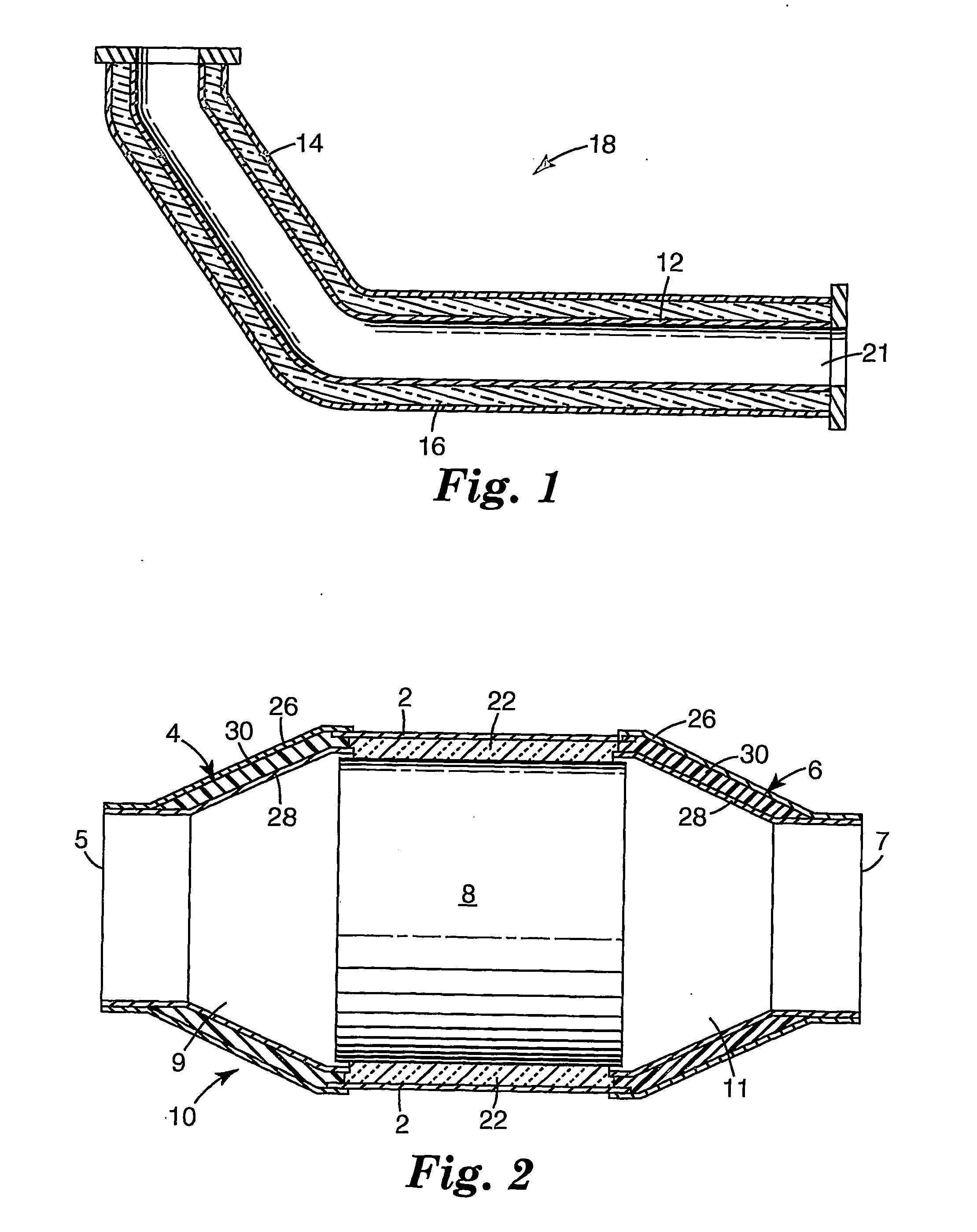Non-classified end cone insulation for catalytic converter
a technology of end cone insulation and catalytic converter, which is applied in the direction of machine/engine, lighting and heating apparatus, separation processes, etc., can solve the problems of reducing the insulation property of heat shields or insulation, reducing the insulation property, and not always practicable or feasible to locate such items. , to achieve the effect of good insulating properties, low cost and good resistance to vibration
- Summary
- Abstract
- Description
- Claims
- Application Information
AI Technical Summary
Benefits of technology
Problems solved by technology
Method used
Image
Examples
example 1
[0069] R-glass fibers (60% SiO2, 25% Al2O3, 9% CaO, and 6% MgO) having a diameter of ca. 10 μm, chopped to a length of 36 mm, obtained from Saint-Gobain Vetrotex, were processed into a web by the following method. The glass fibers were opened in a two-zone Laroche opener. The first zone had a feed speed of 2 m / min and a Lickerin roll speed of 2,500 rev / min. The second zone had a feed speed of 4 m / min and a Lickerin roll speed of 2,500 rev / min. The output speed was 6.5 rn / min.
[0070] The opened fibers were then fed into a conventional web-forming machine (commercially available under the trade designation “Rando Webber” from Rando Machine Corp. of Macedon, N.Y., wherein the fibers were blown onto a porous metal roll to form a continuous web. The continuous web was then needle-bonded on a conventional needle tacker. The needle speed was 100 cycles / min and the output speed was 1.1 m / min. The “weight per area” of the mat could be adjusted as desired.
[0071] The mat of Example 1 was subj...
example 2
[0073] A mat comprising only S-2 glass fibers was prepared by the same method as employed in Example 1. This mat was subjected to RCFT. Results are summarized in Table 3. The mat retained a pressure of at least 17 kPa during the three temperature cycles indicating that sufficient pressure was present to hold the material within the end cone.
example 3
[0074] A two-layer mat was prepared by laminating two separately prepared layers together. The first layer comprised R-glass. The second layer comprised E-glass. Each of the layers was prepared by the method described in Example 1. The two layers were put together by needle-bonding. The mounting mat formed in this manner had two discrete layers of glass of differing compositions. The composition of the two-layer mat of Example 3 is summarized in Table 1.
[0075] The two layer mat of Example 3 was subjected to the RCFT with the S-glass layer positioned towards the hotter of the two platens in the RCFT. The mat retained a pressure of at least 5 kPa during the three temperature cycles indicating that sufficient pressure was present to hold the material within the end cone.
PUM
| Property | Measurement | Unit |
|---|---|---|
| Percent by mass | aaaaa | aaaaa |
| Percent by mass | aaaaa | aaaaa |
| Percent by mass | aaaaa | aaaaa |
Abstract
Description
Claims
Application Information
 Login to View More
Login to View More - R&D
- Intellectual Property
- Life Sciences
- Materials
- Tech Scout
- Unparalleled Data Quality
- Higher Quality Content
- 60% Fewer Hallucinations
Browse by: Latest US Patents, China's latest patents, Technical Efficacy Thesaurus, Application Domain, Technology Topic, Popular Technical Reports.
© 2025 PatSnap. All rights reserved.Legal|Privacy policy|Modern Slavery Act Transparency Statement|Sitemap|About US| Contact US: help@patsnap.com


